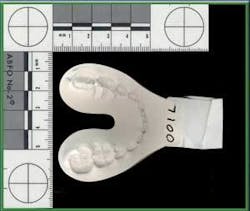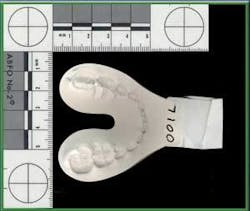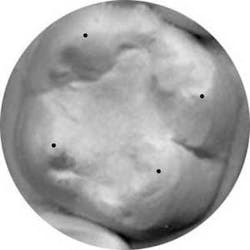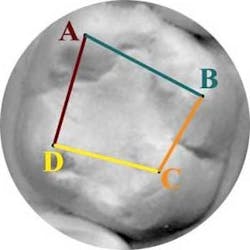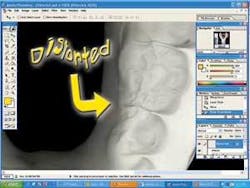Imprints
The Dental Forensic Value of Toothprints®
by Winnie Furnari, RDH, BS
The popularity of Toothprints® (SDS Kerr Corporation, Orange, Calif., www.kerrdental.com) Bite Registration has led dentists and dental hygienists to a much more active part in forensic science. Forensic odontology has seen a surge in the number of dental professionals taking a role. This interest will undoubtedly increase awareness, which can be applied to our daily procedures in private and public practice, and to our educational programs.
When my children were young, it was popular for law enforcement officers to visit schools and community fairs to take fingerprint records. When my children received theirs, I was told to keep the fingerprints in a safe place. This was my first encounter with the need to secure forensic evidence.
Today we have an additional set of prints to secure. Alongside those officers at community events are dentists and dental hygienists taking bite impressions. Bite impressions are also offered in dental offices, for both children and adults.
One of the greatest fears parents have is that their child will get lost or, worse, be abducted. Indicative of this concern is the fact that to date, 34 states have implemented AMBER Alert systems that issue statewide public alerts about missing children.1
Developed by Dr. Dave Tesini, a pediatric dentist from Massachusetts, Toothprints® is a simple, cost-effective way of documenting a patient’s unique tooth characteristics, tooth position within the arch, and maxillomandibular jaw relationship, which are all important identifiers.1 Like fingerprints, dental imprints are unique to every person, so bite impressions serve as an accurate method of identification. Dental restorations and X-rays have historically been the primary basis for dental identification, but the successful fight against tooth decay has left many children with no cavities and, therefore, no dental records.
David Harte, DMD, director of the Massachusetts Masonic Child Identification Program, reports, “Law enforcement officials rarely have ID materials available for teenagers, yet teens are the most likely to become lost, missing, or abducted. Toothprints® offers a very powerful recovery and identification component of any child’s identification kit.”1
According to the Kerr Web site, “Toothprints® is an arch-shaped thermoplastic wafer you can soften in hot water, then place on the patient’s lower arch. The child bites into the wafer for 50 seconds in the same manner as a bite registration taken for prosthetics or orthodontics.” A two-to-three-minute cool-down period in the plastic bag provided1 is required.
This method should not be considered a substitute for obtaining and keeping accurate, conventional dental records. Dental records should include detailed treatment records and radiographs of the dentition and surrounding structures.2
The claim addressed in this article is that the bite impression is for dental identification purposes. The topic of bitemarks and bite registrations as a science provokes controversy. Nonetheless, it is a valuable tool in forensic science, especially if it is used to exclude or show consistency with a victim or perpetrator’s bite. At this time, no adult or child has been identified from a Toothprints® impression. When the time comes, the forensic odontologist will need to follow a protocol to make the prints useful.
The Academy of Forensic Sciences holds a meeting each February. The odontology section makes presentations of original research findings and other papers in the field. In 2005, two experienced and respected members of the Academy presented the first paper on a protocol for using Toothprints® for possible identifications. James McGivney, DMD, and Jon Curtis Dailey, DDS, shared their appreciation for the usefulness of the bite registrations.
This research is not yet published. The Academy of Forensic Science has granted me permission to print from the abstract, and the authors have given me permission to use their information and illustrations to share with the dental hygiene community.
In the information, a Toothprints® examination and comparison protocol was proposed. The protocol was tested, and its ability to correctly discriminate an individual from among a group of similar dentitions was studied.3
A collection of 15 Toothprints® was available for this study. The individuals ranged in age from 3 to 12. Each side of every Toothprints® was both digitally photographed and scanned. The resulting images were brought to Adobe Photoshop as JPG files, and each JPG was manipulated to produce a positive image of the dental structures of interest.3
The cusp tips of various teeth were marked. For the Toothprints® from 3-year-olds, the cusp tips of each primary second molar were marked. From the 7-year-olds, the cusp tips of each permanent first molar were marked. For the 12-year-olds, the cusp tips of each of the permanent second molars were marked. The cusp tip markings were connected with straight lines to produce a circle-like figure for each tooth. For every tooth studied, the lengths of the connecting lines were calculated. Each Toothprints® yielded four groups of numbers, one for each of the studied teeth. Each group contained line lengths and angle measurements. The lower permanent molars usually had five cusp tips, while the rest of the studied teeth had four cusp tips.3
The groups of numbers from each Toothprints® were compared to the groups of numbers from the other Toothprints®. The correct print could be identified in every case.3
The researchers presented several additional points to be considered for further research: 1.) As a child matures, the teeth become worn. This will affect the placement of the tip marking. 2.) There is a variability introduced by Toothprints® produced by different clinicians. 3.) Further study will be done to determine how long a period of time Toothprints® information is valid and useful in dental identifications. 4.) There is a need for a larger and more controlled study. A larger study will produce a larger database that may prove useful in assisting in the identification of missing children.
One very important point is that the clinician must make a properly fabricated bite impression. Researchers have found that errors can impair the usefulness. Of the 15 impressions studied, several had errors. These are noted as bitten through to both sides, bending, or improper placement which caused distortion, among other problems. The authors also suggest that two impressions should be taken - one for the upper arch and one for the lower arch.
The conclusions from this study suggest that when properly used, Toothprints® material can be accurate. If it is properly captured, Toothprints® can be a reliable method to record dental information that is of forensic value. It’s exciting that we are discovering ways to use these imprints as an identification tool, and that we can play a part in parental peace of mind.
The American Dental Association Standard Committee on Dental Informatics is preparing a comprehensive technical report in conjunction with the FBI and the National Center for Missing and Exploited Children on the most beneficial information, images, and items to be included in an identification package.4 The information presented here should be useful for this committee to consider.
All dental professionals should consider playing a more active role in securing forensic evidence. More organizations should advocate and support urge members to become more aware of the role each of us can take in forensic science.
Illustrations courtesy of James McGivney, DMD, and Jon Curtis Dailey, DDS.
References
1 Toothprints® Kerr Dental. Available at http://www.kerrdental.com/products/toothprints. Accessed May 24, 2005.
2 American Board of Forensic Odontology Position Paper. Forensic Odontology News 2005; 3,7.
3 Dailey JC, McGivney J. The dental forensic value and usefulness of Toothprints®. In: American Academy of Forensic Sciences Proceedings. Colorado Springs, Colo.: American Academy of Forensic Sciences 2005; 11:214.
4 Benjamin SD. Dentistry’s role in patient identification. J Prac Hyg 2004; 5:38-40.
